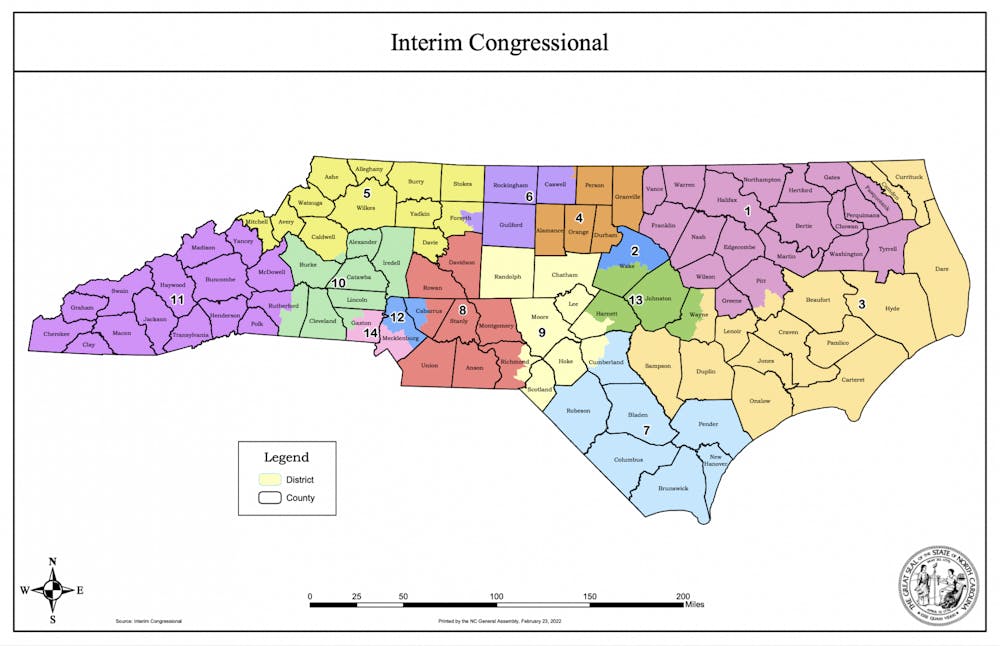After multiple rounds of rejected North Carolina congressional maps due to partisan gerrymandering concerns, a map drawn by nonpartisan redistricting experts has finally been accepted.
The panel of experts drew a new state congressional map after a North Carolina state court rejected a Republican-drawn congressional map last Wednesday. The court also ruled on the same day that newly drawn maps for state House and Senate districts would be accepted.
Earlier, groups representing state Democrats had appealed the legislature-drawn House and Senate maps, while groups representing state Republicans had appealed the congressional map drawn by a court-appointed expert panel.
The rejected maps would have given Republicans six safe seats and Democrats four, leaving four others as tossups. These followed on the heels of the first round of rejected maps on Feb. 4, drawn up in response to the most recent United States census.
Both appeals were rejected by the Supreme Court of North Carolina last Wednesday, which means candidate filing for the 2022 election can begin.
On Friday, Republican North Carolina House Speaker Tim Moore announced that state Republicans filed an emergency appeal to the U.S. Supreme Court. They hope to appeal the state court decision on the basis that state courts don’t have the power that was exerted.
“The trial court’s decision to impose a map drawn by anyone other than the legislature is simply unconstitutional and an affront to every North Carolina voter whose representation would be determined by unelected, partisan activists,” Moore said in a release.
Democratic North Carolina Gov. Roy Cooper also expressed concern about the approved N.C. Senate map.
“Today’s decision allows a blatantly unfair and unconstitutional State Senate map that may have been the worst of the bunch,” Cooper said in a released statement. “That is bad for North Carolina because it strips voters of their voice in our democracy. Our elections should not go forward until we have fair, constitutional maps.”
The new congressional maps proposed and implemented by the court give each party six relatively safe House seats, with the remaining two districts tossups. This would split North Carolina’s congressional districts roughly equally, reflecting the largely even divide between Republican and Democratic voters in the state.
“The General Assembly’s state Senate map relies on misleading and skewed data, contradicting clear guidelines from the N.C. Supreme Court to conduct a district-specific racially polarized voting analysis,” according to Cheryl Carter, interim co-executive director of Democracy NC in a release. “Instead, lawmakers decided to pack Black voters into a single northeastern district to dilute Black voting power, stripping away the ability to elect candidates of their choices in other districts.”
What is redistricting and how does it work?
After every decennial U.S. census, each state must redraw its congressional districts.
The congressional map is being entirely redrawn because North Carolina gained a seat in reapportionment as a result of the 2020 Census. The North Carolina General Assembly has the power to redistrict the state House, state Senate and congressional districts. The House and Senate redistricting committees are responsible for drawing their own maps and work together to come up with a congressional map.
This process opens itself up to gerrymandering, defined by the Brennan Center for Justice as a political manipulation of district boundaries that “produces maps where electoral results are virtually guaranteed even in years where the party drawing maps has a bad year.”
This is usually done by grouping voters of a certain party into districts in which they are the overwhelming majority by design. This prevents these voters from affecting other districts that are not similarly “packed,” allowing the other party to win those districts easier.
“In North Carolina, we are infamous for having issues with redistricting … in a way where politicians choose their voters rather than voters choosing their elected officials,” said Katelin Kaiser, counsel for voting rights at the Southern Coalition for Social Justice.
How did we get here?
Members of the North Carolina legislature started the map-drawing process in July 2021, live-streaming it on the NC General Assembly’s website. The idea was that the process would be fully transparent and open to community input, according to Kaiser.
However, some argue that this wasn’t the reality.
Get The Chronicle straight to your inbox
Sign up for our weekly newsletter. Cancel at any time.
“It wasn’t a transparent process, it wasn’t community-centered and it wasn’t even a racially equitable process at all,” Kaiser said. She said that people did not have the ability to fully participate unless they owned a computer, and even then, it was “very confusing” as to when the meetings were happening, how to live-stream them and where this information was on the website.
“From there, when people did provide public comments, those comments got manipulated and twisted to actually lead a hand to the politicians and not actually reflect the community members’ voices,” Kaiser added.
“With just one overhead camera showing the committee room from an eye-straining distance and no user-facing camera at each workstation, it’s extremely difficult for North Carolinians watching online to see who is drawing maps and to clearly follow along in the process,” said Bob Phillips, executive director of Common Cause NC, in a release.
The maps were eventually passed in November 2021 and were expected to give Republicans a 10-4 advantage, securing at least two additional house seats for the GOP.
On Jan. 11, 2022, a panel of three judges on the Wake County Superior Court unanimously ruled that the new districts drawn did not violate the state constitution. The judges consisted of two Republicans and one Democrat. In their ruling, the judges wrote that “redistricting and the political considerations that are part of that process do not impinge on the right to vote.”
Challengers then appealed the ruling to the N.C. Supreme Court, who ruled on Feb. 4 that the maps were unconstitutional due to illegal partisan gerrymandering. It was a 4-3 decision, split on party lines.
“When a districting plan systematically makes it harder for one group of voters to elect a governing majority than another group of voters of equal size—the General Assembly unconstitutionally infringes upon that voter’s fundamental right to vote,” the Court wrote in a statement.
The legislature had until Feb. 18 to create new maps and send them to a lower court, which then selected a remedial plan. The trial court then approved redistricting plans before noon last Wednesday.
Candidate filing for the 2022 election started Thursday at 8 a.m. Unless the U.S. Supreme Court overturns the court’s decision, these new maps will stand.

Jazper Lu is a Trinity senior and centennial/elections editor for The Chronicle's 120th volume. He was previously managing editor for Volume 119.

